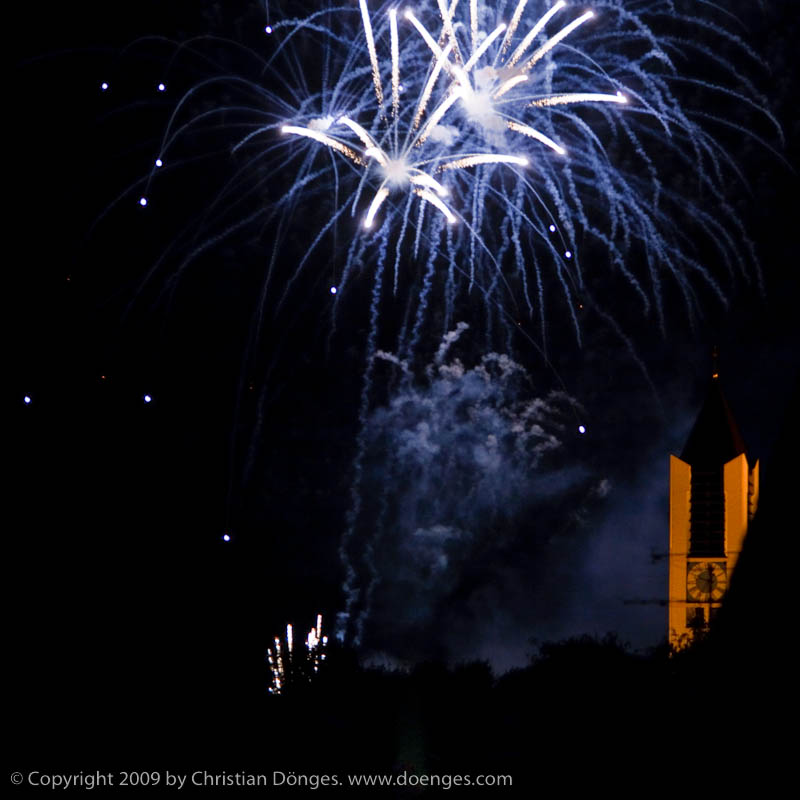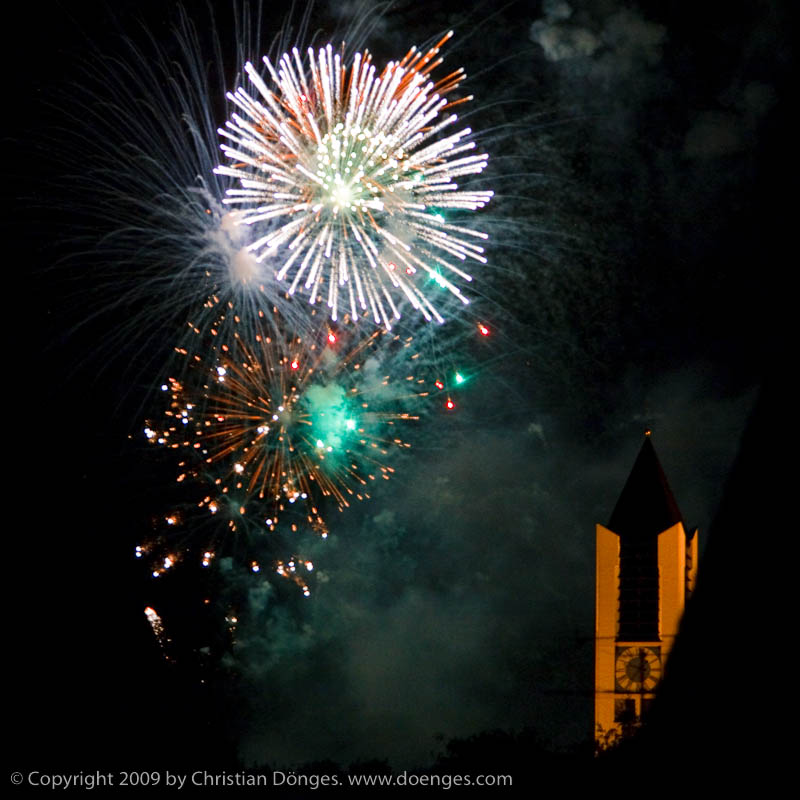I have added a (long) page to the site explaining how to use the Canon WFT-E1 (or WFT-E1A or WFT-E2, E3, E4, or E5) wireless transmitter to push images from your Canon DSLR to a computer running Mac OS X 10.5.
You are currently browsing the archive for the Helpful Hints category.
Freising is having it’s 80th annual fall fair this year and the town celebrated the last day today with some spectacular fireworks:
In case you are wondering, it is actually quite easy to make this kind of photo if you know what you are doing:
- Set your camera on a tripod and use a cable release or a remote control (infra red remote, RadioPopper, PocketWizard, you name it) to trigger the exposure. I use a simple remote control cable.
- Turn off the auto-focus and manually focus the camera (usually to infinity). This is faster and more reliable than having the AF hunt the night sky.
- Crank up the ISO as far as you are willing to live with the noise. For example, on a Canon 5D, ISO 800 is great and ISO 1600 is acceptable. A Nikon D3X will go even higher, as will a Canon 5D mark II. A pocket digicam will probably struggle at ISO 400 and above. Experiment – preferably before the big event.
- Use manual exposure mode and open the aperture as wide as it will go.
- Still in manual exposure mode select a good exposure time. I find that between 1/125s and 1/8s works well.
- Expose at will and enjoy the show!
I usually use the camera screen to judge exposure. That is, I set the aperture wide open and shoot at whatever exposure time I have guessed. Usually 1/60s is a good place to start as any.
It is normal to see some blown highlights in the middle of the explosions and at the back of the rocket engines. Because of this the histogram and the blinkenlights are useless. Instead, ensure that the night sky is black and that the fireworks are clearly visible.
If the sky is too light, shorten exposure time and/or reduce the ISO. Similarly, if the fireworks are too dark, lengthen exposure time and/or increase the ISO.
Once I have set up the exposure correctly I point the camera at a likely section of sky and snap away. Since the exposure will not change, I only change it to get a different effect. There is no need to check every image.
In fact, I simply snap away until either the fireworks stop or I grow tired of taking pictures. It’s a good idea to have some spare batteries and memory cards on hand …
That’s it. Have fun!
We recently received some photos from a family event that were – gasp – made using analog film. You should have seen the look on the face of the dozen or so children when they crowded around the SLR expecting to see a preview on the LCD only to discover that there was no LCD on the back of this camera. Talk about culture shock. 😉
Anyways, the quality of the prints was appaling, as where the scanned images on the CD that came from the processing lab. The negative, however, looked fine to my no-longer-used-to-look-at-negatives eyes. I decided to revitalize an old film scanner I still have in a box. It is a rebadged Pacific Imaging PrimeFilm 1800u scanner, which will turn a negative into a 4 Mpxl file with 16 bits per color channel.
I like using VueScan with flatbed scanners. It is a low-cost, high-power solution and Ed Hamrick does a fantastic job of supporting almost every scanner under the sun. My experience so far has been that you plug in the scanner, start VueScan, and start scanning.
With the PF1800u it turns out to be a little bit more complicated than that:
- Download the latest driver from Pacific Imaging, an application called CyberViewX_SF. Localized non-english variants are available.
- Install the driver at the default location (/Applications).
- Find VueScan on your hard drive and Get Info in the Finder. You can do this by using the context menu (right-click or control-click), hitting CMD-I, or File > Get Info in the menu.
- Make sure “Open using Rosetta” is ticked (see below).
- Connect the scanner to your computer and power it on.
- Start VueScan.
“Open using Rosetta” in the Finder “Get Info” panel.
You can skip steps 3 & 4 if you are using a PowerPC Mac. CyberViewX_SF is a PowerPC application, so Intel Macs need to be told to run PowerPC code because though VueScan is a native Intel application. I wish Pacific Imaging would update their driver!
I had some difficulties because CyberViewX_SF is not in the default install location on my system. In this case, VueScan can not find the driver it needs and complains.
If you – like I – want to put your applications in a non-default place, you can create a soft (or hard) link to it to make VueScan happy:
$ sudo ln -s /Applications/Graphics/CyberViewX_SF /Applications/CyberViewX_SF
where “/Applications/Graphics/” is the location of the CyberViewX_SF folder. That’s it!
Thanks to Ed Hamrick for the great support!
Update: Since Mac OS X 10.7 (Lion), Apple has dropped support for PowerPC code. You can no longer install Rosetta, so your scanner is just a paperweight if you switch to 10.7 or later.
I had an interesting experience with Mac OS X (10.5.6 for the record) today: I use a KVM switch to connect a single keyboard, monitor, and mouse to a number of computers. I swapped my Microsoft Comfort Curve Keyboard 2000 for a Unicomp Customizer 105 (which rocks, by the way!) and started typing away. To my dismay, the ^° key was recognized as <> – and vice versa.
The keyboard layout was still correctly set to a German layout but Mac OS X thought that the KVM switch was the actual keyboard (it certainly identifies itself as a HID). So it looks like Mac OS X can not see that the keyboard type has changed and the wonderfully simple process that works when connection a keyboard directly fails to even get started.
Read the rest of this entry »




